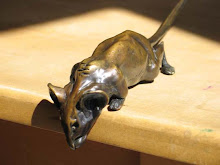Which must explain how I got my words all mixed up.
It felt good to push my knuckle into a particularly sore and tender spot. I tried to tell Meridee.
‘Ah, it feels like I have a fovea just like babies do’.
‘What did you say? You have a faux beard, just like babies do? I’ve never seen a baby with a beard. What on earth are you talking about?’
‘No. A fovea. You know, in my head.’
‘What kind of phobia?’
Clearly this was going nowhere! For starters, I should have said 'fontanel'.
So a soft spot on my head that felt good to massage had become a phobic baby disguised as Fidel Castro.
Clearly my message wasn’t getting through, although it did make us laugh.

I feel the same way about being told unrecognizable paintings are important works of genius that communicate complicated intellectual ideas.
Words communicate complicated intellectual ideas.
Using words to explain ideas can lead to mis-communication, even though words are the right language to use.
Which is why I’ve always been doubly suspicious of incomprehensible visual art that requires an essay from a noted scholar or critic to explain what it’s really supposed to be saying.
If it was that complicated to explain, why would you try and use paint instead of a pen?
It's always seemed fishy to me.
Is the art just a ‘STOP’ sign being used to get you to pay attention to the critic’s essay?
In which case it’s the essay that should be up for consideration as meaningful, not the art.
I guess they need each other. Perhaps the learned critic pretends the deeply meaningful and very important 'STOP' sign has something to do with his discourse, and the artist pretends the critic correctly interpreted his idea.
Would no one pay attention to the idea man without the art to get you to stop and listen?
That’s my guess.
The less about anything the art appears to be, the easier the critic can attach any idea he likes to it.
But for you to listen you have to believe the art is very important.
The critic’s got plenty of things to talk about on hand, he’s a writer after all. So the writers gravitate to ever more meaningless work, and declare it has ever more profound importance that they need to explain.
The less you can get from the art the better: it will be less likely to contradict their point of view on whatever notion it is they want to discuss.
If you don't believe the art is very important, you might not realize you are supposed to pay attention to what they have to say about it. So they declare 'this is a work of genius: now you'd really better listen to me!'
So I say the art they pick is often just to be used as a handy STOP sign.
The art has its job to do, which it does, but let’s not get all carried away.
If you can't tell what it's supposed to be saying by looking at it, how important can it really be?
Unless of course you really can communicate complex intellectual ideas with a shambles on canvas, and I, along with a lot of other reasonably intelligent people just can’t see it.
But I always get the sneaky feeling I’m being had by some dishonesty and someone somewhere is having a jolly good laugh!
Not always, but often enough to make me blow off steam about it!
Meridee just read this and said ‘remember that they say a picture’s worth a thousand words’.
I said ‘Yes, but only if it’s a picture OF something’.
She came back with ‘I guess with modern art then you could say a picture spawns a thousand words’.
Now I’m off to solve the healthcare debate using only an accordion and some cymbals.
My website... SteveWorthingtonArt.com - Sculpture that loves you back
My Etsy store, CritterVille.












No comments:
Post a Comment